It’s often good practice when predator fishing to keep your main line up and off the deck to ensure a truly low-resistance presentation. Buoyant leger attachments have been on the market for years, most notably in the form of Middy’s ‘Buoyant Leger’ and Fox’s ‘Leger Stems’.
Annoyingly, the Middy ones have become difficult to find and the Fox ones tend to just fall apart! They’re way too fragile for me to use with any confidence so I started modifying them. Then I thought instead of paying so much for a product I have to alter anyway, I may as well manufacture my own! The ones I came up with may not look too refined – but they work and are both robust and cheap.
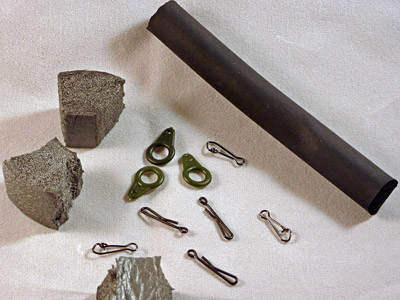 All the materials you need to put these stems together is some standard run rings, some Genie mini clips, either some foam pipe lagging or rig foam (or, a more neat but expensive option: some 12 to 15 mm diameter expanded neoprene cord – used for high-pressure seals), some 8lb power gum, some small snap-link clips and some shrink tubing (optional). The only tools you need are a Stanley or craft knife, a small sharp pair of scissors and a large hook-type baiting needle.
All the materials you need to put these stems together is some standard run rings, some Genie mini clips, either some foam pipe lagging or rig foam (or, a more neat but expensive option: some 12 to 15 mm diameter expanded neoprene cord – used for high-pressure seals), some 8lb power gum, some small snap-link clips and some shrink tubing (optional). The only tools you need are a Stanley or craft knife, a small sharp pair of scissors and a large hook-type baiting needle.
Most of the components can be picked up for next to nothing. For example, a quick search for ‘fishing run rings’ on a certain auction website brought up someone selling 50 for £3.20 including postage! Also, you can pick up a metre length of pipe insulation for less than a quid from a DIY or plumbing shop and that will give you enough foam to make hundreds of leger stems! The size I’ve found to be perfect is 64mm outside diameter, with a 24mm hole in the centre.
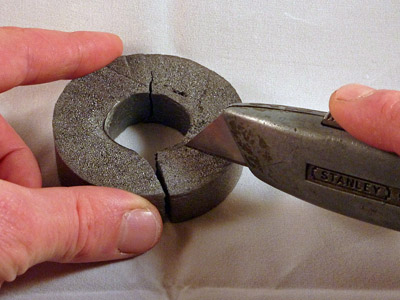 The first step – if using the pipe lagging rather than neoprene – is to carefully slice off a disc of about 15mm thickness. Then cut this into eight equal-sized pieces, which should look a bit like grey pineapple chunks!
The first step – if using the pipe lagging rather than neoprene – is to carefully slice off a disc of about 15mm thickness. Then cut this into eight equal-sized pieces, which should look a bit like grey pineapple chunks!
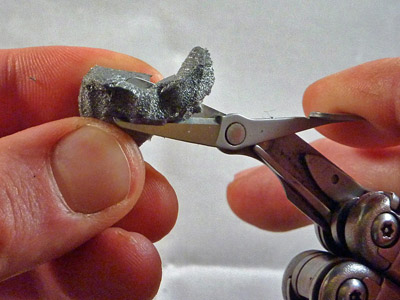
Next, carefully chop the square edges off the chunk and slowly whittle it down into an egg shape, with a wider top and a narrower bottom. If you’re using neoprene, slice off a 22mm long cylinder and shape it in a similar fashion.
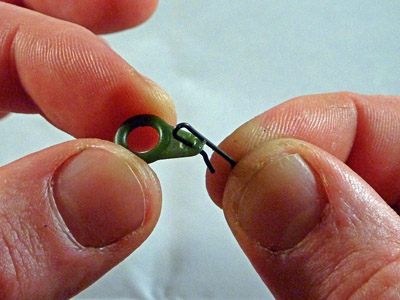
Step 3 – Take a Genie clip and insert it into the small eye of a run ring; feed it down until the run ring sits in the bend of the clip.
Step 4 – 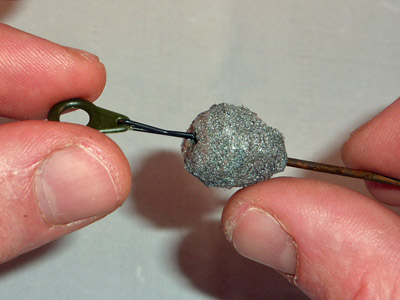 Pierce the foam with a baiting needle, starting from the narrow end, and thread it down so that the needle end protrudes through the other side of the foam. Hook into the small eye of the Genie clip and push the foam down over the clip. Force the foam over the run ring until it nestles against the large-bore eye.
Pierce the foam with a baiting needle, starting from the narrow end, and thread it down so that the needle end protrudes through the other side of the foam. Hook into the small eye of the Genie clip and push the foam down over the clip. Force the foam over the run ring until it nestles against the large-bore eye.
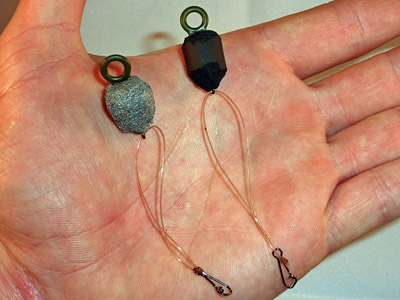 Step 5 – At this point you have two options, depending on how far you want your run ring to pop-up off the bottom. You can either hook the snap link into the Genie clip eye as shown at the top of this feature or, cut a length of power gum, thread this through the eye and tie into a loop.
Step 5 – At this point you have two options, depending on how far you want your run ring to pop-up off the bottom. You can either hook the snap link into the Genie clip eye as shown at the top of this feature or, cut a length of power gum, thread this through the eye and tie into a loop.
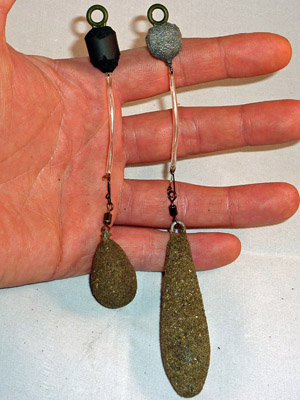 A length of shrink tube can then be threaded onto the gum with your baiting needle, making sure it also covers the Genie clip eye. Then attach your snap link to the power gum and carefully apply heat to shrink the tubing. This makes a semi-rigid boom between the run ring and the snap link, which makes it less tangle-prone.
A length of shrink tube can then be threaded onto the gum with your baiting needle, making sure it also covers the Genie clip eye. Then attach your snap link to the power gum and carefully apply heat to shrink the tubing. This makes a semi-rigid boom between the run ring and the snap link, which makes it less tangle-prone.
The power gum acts as your weak link, so it’s fish safe too. If thick bottom weed or debris is likely to be encountered, you can make the power gum link as long as you like, providing your shrink tubing is in long enough sections to cover it.
All that is left to do is thread your mainline through the run ring, clip on a lead, tie on your end rig and you’re ready to fish!











